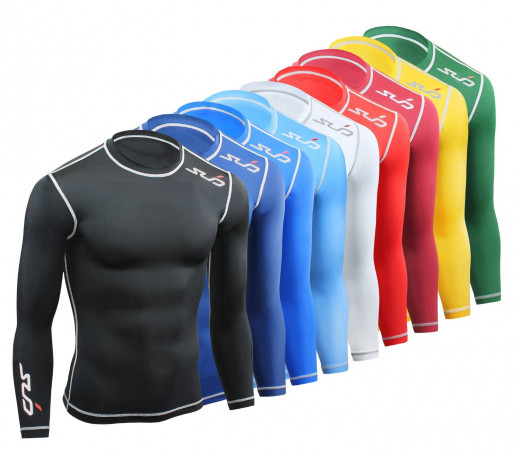Compression Clothing For Injuries, Recovery, And Blood Clots

What Is Compression Clothing
Compression clothing is a great addition to athletes who train extremely hard and those regular folks who suffer with poor circulation or other venous issues. Compression clothing is used to help keep the muscles warm and to help the blood vessels move blood back towards the heart. If the blood pools due to muscle fatigue or an injury then you're at risk of developing a blood clot. By donning some compression clothing after an intense workout you can significantly reduce that risk.
To get the desired effect the compression item will need to be a very tight fit, but not so tight that you lose circulation; any form of compression clothing will feel tight against the skin and it should feel tighter at the base of the first joint and get slightly loser as it comes towards the body. This is known as graduated compression and is the most common form.
Graduated compression clothes come in different strengths but ultimately they all do the same job it just depends how much extra assistance your body needs. The tension in the clothing helps to keep the blood pumping back towards the heart and also to stop it pooling in the lower limbs or flooding back towards the extremities.
When you hear the word "compression clothing" I'm sure the first thing you think of is the old style "Granny tights". Well, while that type is still used to treat circulation and venous problems in us non-athletes - and in my opinion the best way - there are actually loads of different options to suit every style.
What Types Of Compression Clothing Are There?
So, what can you get besides the old-fashioned stockings? Well, it all depends on which body part you would like the compression for. If you're a runner or cyclist you'll probably want something to do with the lower body; triathlon athletes will need something all round; weight lifters will need core and arm support; and there are those athletes who need a specific piece for their recover sessions.
To make things simple I'll provide an extensive list on all the different types of compression clothing that you can get. Just below this list you'll also find another list taking you to Amazon as they stock a great selection of compression clothing too. Each item I have selected has been reviewed so you can make an informed decision and also compare with similar products. Anyway, on to the compression clothing list:
- Baselayer Leggings: normally worn during a running or cycling session.
- Compression Socks: normally worn by runners as they aid in circulation with the feet as well as the ankles and calf muscles.
- Calf Guards: normally worn during recovery but can also be worn during training.
- Quad Guards: designed for weight-lifters and explosive lower body movements.
- Compression Shorts: great for runners and cyclists who suffer from quad and hip fatigue.
- Compression Knee Sleeve: often known as a knee support, it helps to reduce the risk of injury by stabilizing the joint and tendons, and absorbing some of the shock from running or jumping.
- Recovery Leg Sleeve: similar to standard compression stockings but used specifically during recovery periods.
- Compression Arm Sleeve: deep vein thrombosis can occur in the arms so if you're at risk you can wear the sleeves during travel. They are also useful during recovery sessions for weight-lifters and cyclists.
- Compression Elbow Sleeve: normally worn by those who constantly use the upper body such as tennis players or basketball players. It keeps the joint and tendons stable to reduce the risk of injury.
- Compression Gloves: not normally worn by athletes but occasionally seen on weight-lifters who suffer from joint pain from lifting too much.
- Compression Baselayer Top: extra support for upper body workouts and those who play sports such as basketball.
This is not a fully comprehensive list as new items are coming out every few months. However, if something new and exciting appears on the market then I will update it here for everyone to see.
Just below is a selection of my favorite compression items so feel free to take a look. After that you'll also receive some information on problems with the veins that also require compression clothing to treat and prevent those conditions.
Compression Clothing On Amazon

How Do Compression Sleeves and Socks Work?
Compression Leggings

Compression Clothing For Athletes
There have been many studies into how compression clothing affects the performance of an athlete. Some studies say that there is no specific benefits to wearing compression clothing but other studies, as well as the comments from athletes, have shown positive reasons for wearing them before, during, and after training.
Manufacturers who sell these items also have reasons for athletes to wear them but that's mainly for their own profit. However, based on science and fact the general consensus from the scientific/medical community and the manufacturers is that wearing compression stockings optimize blood flow, reduce muscle fatigue, and generally make the muscles more efficient.
Main Benefits Explained
- Enhancing blood circulation: the graduate compression helps return blood to the heart
- Enhancing warm-up time as it increases the skin temperature and muscle temperature
- Increasing vertical jump height: see studies by Kraemer, Bush et al. 1996; Kraemer, Newton et al. 1997; Kraemer, Bush et al. 1998
- Improving repetitive jump power: see studies by Doan, Kwon et al. 2003
- Reducing the risk of injury by increasing the torque around joints
- Improving recovery after strenuous exercise by helping to remove blood lactate quicker: see studies by Berry and McMurray 1987; Chatard, Atlaoui et al. 2004
- Also reduces the effects of delayed onset muscle soreness because of the efficient removal of lactate.
The general consensus from athletes (looking around their blogs and from conversations with them) is that compression clothing keeps the muscles warm which helps to prevent muscle strain and fatigue. The clothing also wicks sweat away from the body to prevent chafing and rashes.
Compression stockings are the not the be all and end all of athletic clothing but it does help, especially in recovery. If you're still debating on whether you should get some I would say to try it and see how it goes. If it works for you then great, if it doesn't then at least you know and you can stop wasting your time and try out some other techniques.
Compression Stockings For Problems With Veins

Do you use compression clothing?
Compression Clothing For Vein Problems
Compression socks and stockings have been used in the medical field for quite some time now. They are mainly used to treat tired aching and heavy legs, ankle swelling (edema), varicose veins and spider veins. In some cases wearing compression stockings can prevent these in the first place if you are prone to them.
You will also be advised to wear compression stockings if you have suffered from deep vein thrombosis, venous insufficiency or post-thrombotic syndrome, lymph-edema, post-sclerotherapy, and other venous conditions.
How Varicose Veins Are Formed
Final Word
Please be advised that I am not a medical professional and this article is just based on my own knowledge and experiences. If you have any medical problems, questions, or needs please seek advice from your health care professional.
Related Articles
- The Best Sports Bra for Large Breasts
For those looking for the best sports bra for large chests and big breasts this is the bra. Women who are plus sizes or have average body weight will find this is the best running bra on the market. I rate this the best sports bra for large breasts b - Review of Hip Hop Abs Created By Shaun T
Review of the rock hard abs routine Hip Hop Abs by Beachbody's Shaun T.








